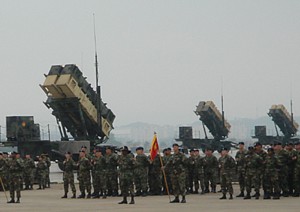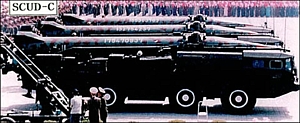 Nuclear
Brief October 13, 2005 Nuclear
Brief October 13, 2005
Missile Defense Planning on the Korean
Peninsula
The Korean Peninsula is one of the most important test beds for the U.S.
missile defense program. Just how this planning occurs and the lessons
learned are not well know. But in October 2002, the Air Force released
a partially declassified copy of a 7th Air Force briefing on the
Theater Missile Defense (TMD) "strategy we are employing on the Korean
Peninsula."The briefing examines how the U.S.
military detects and warns Korean-U.S. Combined Forces Command (CFC) of
North Korean missile launches, and how the Patriot missile defense
system currently deployed in South Korea is intended to defend against
incoming missiles. It also describes various attack operations, and
explains "how we're applying the lessons learned to today's plan."
 |
Patriot anti-ballistic missile interceptors, like these from
the 1st Battalion (Patriot) 43rd Air
Defense Artillery (ADA) in South Korea, are tasked to protect
U.S. military forces against North Korean ballistic missiles.
Image: U.S. Army |
Organization
As of 1998, the U.S. had six Patriot
batteries deployed in South Korea. The batteries were organized
under the 1st Battalion (Patriot) 43rd Air Defense
Artillery (ADA) Unit, the only Patriot battalion on the Korean
peninsula. In October 1994, the 2nd Battalion 7th
Air Defense Artillery unit (2-7 ADA) was replaced by the 1-43 ADA, which
had been rushed to Korea in March 1994 in response to the crisis that
followed North Korea's blocking of IAEA inspections and intention to
withdraw from the Non-Proliferation Treaty (NPT). The mission of the
1-43 ADA is "the Tactical Ballistic
Missile Defense of the peninsula."
In 1998, the six Patriot batteries
were deployed at Suwon Air Base (Alpha and Bravo Batteries), Osan Air
Base (Charlie and Delta Batteries), and Kunsan Air Base (Echo and
Foxtrot Batteries). By 2005, the 1-43 ADA has been reduced to four
Patriot batteries: A, B, C, and D.
In anticipation of new missile
defense systems, the U.S. Army is reorganizing the ADA units into
composite AMD or MAMD (Maneuver Air and Missile Defense) battalions
consisting of Patriot, Avenger and Sentinel systems; or Patriot pure
battalions.
Offensive-Defensive Battle
Planning
The Air Force briefing helps
illustrate how the U.S. military expects North Korea to employ Scud
missiles in a crisis and how they can most effectively be countered. The
briefing suggests that planning for defensive and offensive operations
are closely intertwined, and it underlines the extremely short warning
time that faces any decision making process in response to or
preparation for a North Korean missile attack:
"A TBM launched from the SCUD
belt will impact OSAN in only [deleted]. It takes between [deleted]
to detect the TBM and to diseminate [sic] the warning. This only
leaves [deleted] to take advantage of the warning. Saving seconds in
important."
The briefing outlines three
scenarios for how North Korea may choose to launch its missiles. Each of
these scenarios demands different targeting strategies:
-
launch exclusively from
underground facilities;
-
disperse launchers in the field;
or
-
use a combination of the two.
Of these three, the third is
described by the briefing as "the most likely."
For North Korea to hide the Scuds in
underground facilities and essentially roll them out only to launch
could be seen as the strategy that would most complicate U.S. targeting
because of the brief warning time. However, the briefing concludes that
such an employment "makes the targeting process easier for us since they
remain at known locations."
 |
North Korean SCUD-C mobile launchers. Despite
advances in U.S. weapon systems, "the launcher remains the most
difficult target to hit," according to a declassified U.S. Air
Force briefing.
Image: GlobalSecurity.org |
Once deployed in the field, by
contrast, the launchers are vulnerable only if they have been found.
This may sound obvious, but the point is to emphasize that this is one
of the most critical stages in the targeting process. Dispersion
"complicates our targeting solution greatly," the briefing underscores
and adds: "Despite advances in our weapon systems, the launcher remains
the most difficult target to hit." Targeting the storage facilities or
logistics is much simpler.
Once the North Korean mobile
launchers stop and begin preparation to launch their missiles, their
vulnerability increases greatly. But even at this stage targeting is by
no means assured. "Although [launchers are] vulnerable during setup, we
do not know where to look until the launch occurs," the briefing states.
"At that point, it is to [sic] late to strike since the [launcher] will
be gone from the area within two minutes" after the missile is fired.
"Launch points, detected by any means," the briefing concludes, "are not
targets" because the "ability of a [launcher] to hide after launch is
far too rapid."
In a crisis on the Korean peninsula,
the briefing suggests, U.S. forces would not be "Scud hunting" for
individual launchers to destroy, but would instead concentrate on having
"the greatest war-fighting impact, and that is to destroy the TMD
[theater missile defense] infrastructure."
This Air Force briefing is further described in the
article
"Preemptive Posturing," Bulletin of the Atomic
Scientists, September/October 2002.
|

